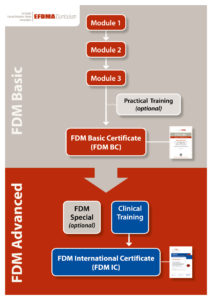Training regulations of the European Fascial Distortion Model Association
Entry requirements
Members of a healthcare profession. They have to have the license to treat their patients with manual techniques, including mobilization techniques either independently or on referral by a medical doctor within the framework of their occupational profile and according to the applicable local laws.
General information
The curriculum of the EFDMA regulates the training: FDM Basic (Module 1-3), FDM Basic Certificate (FDM BC), Practical Training, FDM Advanced (Clinical Training, FDM Special), FDM International Certificate (FDM IC) and the training to become a certified FDM instructor.
FDM Basic is exclusively being taught by certified and qualified FDM-Instructors who have been trained according to the guidelines of the EFDMA curriculum.
The EFDMA curriculum offers various modules and thus offers maximum flexibility and a wide variety of courses for the participants.
The complete course calender and information about the particular course organizer can be found on the respective subpages.
FDM Basic
FDM Basic comprises 3 modules. Each module consists of a minimum of 20 teaching units (TU). Module 1 is the access to the FDM training and thus has to be attended first. Module 2 and 3 can be attended in varying order, but it is recommended to follow the sequence of the modules.
Module 1:
- General introduction to the Fascial Distortion Model (FDM)
- General principles of examination and treatment
- Specific examination and treatment of shoulder, knee and ankle with the Typaldos method
Module 2:
- Revision and consolidation of the basics
- Specific examination and treatment of pelvis/hip, lower back, middle back and neck with the Typaldos method
Module 3:
- Revision and consolidation of the basics
- Specific examination and treatment of the lower and upper extremities and the head region with the Typaldos method
Practical Training
Entry requirements: Attendance of the FDM Basic courses (Modules 1-3), the FDM Basic Certificate (FDM BC) is not necessary.
In the Practical Training courses the contents of the FDM Basic courses are revised and consolidated. The detailed contents are described in the course calendar.
FDM Basic Certificate (FDM BC)
After attendance of modules 1-3 the participants can take a final examination to obtain the FDM Basic Certificate (FDM BC). Those who pass the examination successfully have the right to attend the advanced FDM seminars.
In addition the successful candidate can be included in the list of FDM practitioners.
FDM BC holders have to understand the FDM in principle and be able to apply the fundamentals of the Typaldos method. (cf. Criteria_FDM_BC)
FDM Advanced
This includes all continuing courses based on the 6 distortions defined by Typaldos.
Entry requirements: at least FDM Basic Certificate (FDM BC) according to the EFDMA curriculum.
The topics are listed in the EFDMA calendar of events.
Clinical Training
More intense exploration of the Fascial Distortion Model and the Typaldos method to safely master theory and practice. Application of the clinical approach illustrated by practical examples. Requirements: FDM Basic Certificate FDM BC. For admission to the FDM International Certificate participation in a Clinical Training is obligatory.
FDM Special
Advanced approaches, new angles and possibilities in theory and practice based on the fundamental FDM concept and its 6 distortions, as well as historical and future perspectives. Requirement: FDM Basic Certificate (FDM BC).
FDM International Certificate (FDM IC)
Candidates who successfully obtained the FDM Basic Certificate (FDM BC) and practically applied the FDM and the Typaldos method for a minimum of 12 months can be admitted to the FDM International Certificate (FDM IC) examination of the EFDMA. Further requirements include shadowing FDM instructors/ FDM IC (on-site-visits) and supervisions with FDM instructors and participation in an FDM Practical and Clinical Training (IC Guidelines).
The FDM IC examination comprises a theoretical and practical part and is conducted in front of a board of examiners (FDM instructors).
With this certificate the EFDMA confirms that according to the international guidelines of the curriculum the FDM practitioner is particularly qualified to deliver FDM treatments and thus is marked on the list of practitioners on the EFDMA website with IC recommended.
Holders of the FDM IC certificate must master the Typaldos method.
Find here more informations about the requirements, dates & guidelines here: FDM IC.
In co-operation with the FDM Global Organization FDMGO (American Fascial Distortion Model Association/FDM Asian Association).
Training to become a certified FDM instructor
Practitioners can start the instructor training of the EFDMA after successfully completing the FDM IC certificate. The first step is the application to the Qualifying. Requirements are, among other things, notable professional competence and the ability to convincingly present the FDM and the Typaldos method and represent the aims of the EFDMA. More information on the current application criteria can be obtained directly from the EFDMA (office@fdm-europe.com).

